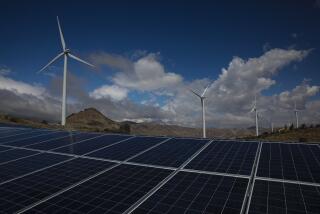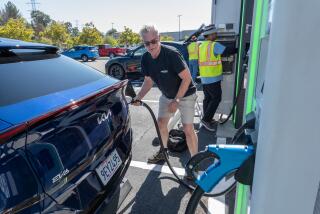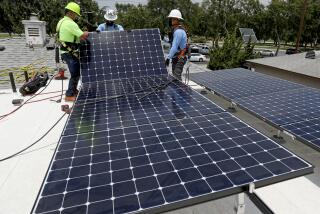Op-Ed: If California wants to go carbon-free, it needs to end its nuclear moratorium
A new state law signed this month, SB 100, requires all of California’s electricity to come from zero-carbon sources by 2045. Many news reports advertised the law as a mandate for renewable energy, but lawmakers in Sacramento quietly acknowledged that the state may need more than wind turbines, solar panels and hydroelectric dams to meet its climate goals. The new law allows up to 40% of the state’s electricity to come from other zero-carbon sources, including nuclear energy and fossil fuel plants, as long as they capture their carbon emissions.
Wind and solar are “intermittent renewables” — the wind doesn’t always blow and the sun doesn’t always shine. There is a limit to hydroelectric power as well — new dams face significant opposition. Recent modeling by a team of MIT researchers drives these limits home. They found that electricity systems powered entirely by wind, water and solar energy would cost substantially more than systems that have “firm low-carbon resources,” such as nuclear and carbon capture. This would hold true even if, as expected, renewable energy technologies become much cheaper over time, and even if California were to join a much larger regional or national renewable energy grid.
With retail electricity prices in California already among the highest in the nation, the Legislature was wise to include nuclear power and carbon capture in the mix of energy choices for the future. But to ensure that California has the best chance of getting to zero emissions at costs that its citizens and businesses can tolerate, Sacramento needs to take another important step: Repeal the state’s outdated moratorium on construction of new nuclear plants.
New technological solutions are also on the horizon that may make nuclear waste disposal much cheaper, easier and faster to address.
The moratorium was established in the 1970s amid public concern about the storage of nuclear waste. The state banned the construction of new nuclear plants until the federal government constructed a facility for long-term waste disposal. In the late 1980s, Washington designated Yucca Mountain, in Nevada, as the nation’s sole depository for high-level radioactive waste. But California never lifted its nuclear-plant moratorium.
Since then, the Yucca Mountain repository has become embroiled in political disputes, and it seems unlikely to be built any time soon. California shouldn’t put its climate future on hold until the federal government gets its act together on Yucca Mountain. Although waste disposal remains controversial, spent fuel has been stored safely for decades at U.S. and European reactors, in thick concrete casks, with virtually no detriment to public health. These on-site casks are carefully monitored and can be replaced when they reach the end of their useful lifetimes.
New technological solutions are also on the horizon that may make nuclear waste disposal much cheaper, easier and faster to address. A Berkeley startup, Deep Isolation, proposes the use of new drilling methods to bury nuclear waste many times deeper than Yucca Mountain, at a fraction of the cost. Many advanced reactor designs, meanwhile, produce far less waste than traditional nuclear plants, and several can use “recycled” fuel, which is commonly done in France.
Despite the moratorium on plant construction, California has become a hotbed for nuclear innovation. Oklo, in Sunnyvale, is working on small, modular reactors that are cheaper and faster to build than traditional reactors. Kairos, in Oakland, is engineering a “passively safe” reactor that shuts itself off if a problem is detected. TAE, in Orange County, is experimenting with fusion instead of fission, which has the potential to generate many times more power than traditional reactors.
As long as the moratorium is in place, these startups will have to go outside of California to demonstrate and commercialize their technologies. Eventually, California could lose out on advanced nuclear altogether to countries like China, which strongly supports the industry.
Whether made in California or imported, the importance of nuclear power for the climate is most clearly illustrated in its absence. When the San Onofre plant near San Diego was shuttered in 2012, power generation from natural gas in California increased substantially. Although natural gas is better for the climate than coal, it is the dirtiest generation technology in widespread use in California, and is much worse for the climate than nuclear.
Meanwhile, the last operating nuclear plant in the state, Diablo Canyon, on the Central Coast, is scheduled to be retired in the mid-2020s. This single plant provided enough clean energy in 2017 to meet about one-tenth of California’s total electricity needs — almost as much as all the solar power in the state put together. The preliminary closure plan for Diablo Canyon included a promise to replace it entirely with renewables. But the final plan approved by the Public Utilities Commission earlier this year predictably reneged on that, leaving a strong possibility that carbon-polluting fossil fuels will fill the gap.
Enter the Fray: First takes on the news of the minute from L.A. Times Opinion »
For too long, overheated claims about the risks associated with nuclear waste disposal have been a crutch that California policymakers have relied upon to avoid the nuclear question. But it should be clear that an affordable clean energy future for California will likely require a role for nuclear power. The state is on the road to 100% zero-carbon electricity. The nuclear moratorium, unchanged since 1976, is a significant and underappreciated roadblock to that goal.
Ted Nordhaus is the executive director and Jameson McBride is the energy and climate analyst at the Breakthrough Institute in Oakland.
Follow the Opinion section on Twitter @latimesopinionand Facebook
More to Read
A cure for the common opinion
Get thought-provoking perspectives with our weekly newsletter.
You may occasionally receive promotional content from the Los Angeles Times.






